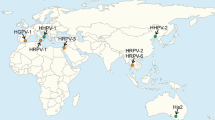Summary
An intracellular symbiont was isolated from the mycetocyte of the pea aphidAcyrthosiphon pisum, and its genomic DNA was compared with those ofEscherichia coli andMycoplasma capricolum with respect to nucleotide composition and kinetic complexity. Thermal dissociation, CsCl density equilibrium centrifugation, and high-performance liquid chromatography of the nuclease P1 digest all indicated that the G+C content of the endosymbiont DNA is as low as 30%. In this respect, the endosymbiont resembledMycoplasma species. The reassociation kinetics of genomic DNA labeled by nick translation suggested that the endosymbiont genome is 1.4×1010 daltons in size, about 5 and 18 times as large as those ofE. coli andM. capricolum, respectively. The results were confirmed by reassociation of endosymbiont DNA labeled by incubation with [3Hthymidine in Grace's medium. The endosymbiont genome of the aphid was about 500 times larger than those of leafhopper endosymbionts previously analyzed by ultracentrifugation. These characteristic properties of the aphid endosymbiont genome are discussed in connection with the evolution of cell organelles, and with reference to a previous finding that most of the genes of the aphid endosymbiont are not expressed when present intracellularly.
Similar content being viewed by others
References
Britten RJ, Kohne DE (1968) Repeated sequences in DNA. Science 161:529–540
Fujimoto M, Kuninaka A, Yoshino H (1974) Substrate specificity of nuclease P1. Agr Biol Chem 38:1555–1561
Gojobori T, Li W-H, Graur D (1982) Patterns of nucleotide substitution in pseudogenes and functional genes. J Mol Evol 18:360–369
Hinde R (1971) The fine structure of the mycetome symbiotes of the aphidsBrevicoryne brassicae, Myzus persicae, andMacrosiphum rosae. J Insect Physiol 17:2035–2050
Ikeda H, Tomizawa J (1965) Transducing fragments in general transduction by phage P1. I. Molecular origin of the fragments. J Mol Biol 14:85–109
Ishikawa H (1982a) DNA, RNA and protein synthesis in the isolated symbionts from the pea aphid,Acyrthosiphon pisum. Insect Biochem 12:605–612
Ishikawa H (1982b) Isolation of the intracellular symbionts and partial characterizations of their RNA species of the elder aphid,Acyrthosiphon magnoliae. Comp Biochem Physiol [B] 72:239–247
Ishikawa H (1982c) Host-symbiont interactions in the protein synthesis in the pea aphid,Acyrthosiphon pisum. Insect Biochem 12:613–622
Ishikawa H (1984a) Molecular aspects of intracellular symbiosis in the aphid mycetocyte. Zool Sci 1:509–522
Ishikawa H (1984b) Characterization of the protein species synthesized in vivo and in vitro by an aphid endosymbiont. Insect Biochem 14:417–425
Ishikawa H (1984c) Control of macromolecule synthesis in the aphid endosymbiont by the host insect. Comp Biochem Physiol [B] 78:51–57
Ishikawa H, Yamaji M (1985) Protein synthesis by intracellular symbionts in two closely interrelated aphid species. Biosystems 17:327–335
Ishikawa H, Yamaji M, Hashimoto H (1985) Symbionin, an aphid endosymbiont-specific protein. II. Diminution of symbionin during post-embryonic development of aposymbiotic insects. Insect Biochem 15:165–174
Kirk JTO (1976) Chloroplast nucleic acids. In: Fasman GD (ed) Handbook of biochemistry and molecular biology, nucleic acids, 3rd ed, vol 2. CRC Press, Cleveland, pp 65–240
Li W-H (1983) Evolution of duplicate genes and pseudogenes. In: Nei M, Koehn RK (eds) Evolution of genes and proteins. Sinauer Associates, Sunderland, Massachusetts, pp 14–37
Mahler HR (1983) The exon:intron structure of some mitochondrial genes and its relation to mitochondrial evolution. Int Rev Cytol 82:1–98
Mandel M, Schildkraut CL, Marmur J (1968) Use of CsCl density gradient analysis for determining the guanine plus cytosine content of DNA. Methods Enzymol 12B:184–195
Maniatis T, Fritsch EF, Sambrook J (1982) Molecular cloning, a laboratory manual. Cold Spring Harbor Laboratory Press, Cold Spring Harbor, New York, pp 207–209
Margulis L (1981) Symbiosis in cell evolution, life and its environment on the early Earth. WH Freeman, San Francisco
Marmur J, Doty P (1962) Determination of the base composition of deoxyribonucleic acid from its thermal denaturation temperature. J Mol Biol 5:109–118
Normore WM (1976) Guanine-plus-cytosine composition of the DNA of bacteria, fungi, algae and protozoa. In: Fasman GD (ed) Handbook of biochemistry and molecular biology, nucleic acids, 3rd ed, vol 2. CRC Press, Cleveland, pp 65–240
Rigby PWJ, Dieckmann M, Rhodes C, Berg P (1977) Labelling deoxyribonucleic acid to high specific activity in vitro by nick translation with DNA polymerase I. J Mol Biol 113:237–251
Schwemmler W (1983) Analysis of possible gene transfer between an insect host and its bacteria-like endocytobionts. Int Rev Cytol [Suppl] 14:247–266
Schwemmler W, Hobom G, Egel-Mitani M (1975) Isolation and characterization of leafhopper endosymbiont DNA. Cytobiologie 10:249–259
Smith MG (1967) Isolation of high molecular weight DNA from normal and phage-infectedEscherichia coli. Methods Enzymol 12A:545–550
Sullivan D, Palacios R, Stovnezer J, Taylor JM, Faras AJ, Kiely ML, Summers NM, Bishop JM, Schimke RT (1973) Synthesis of a deoxyribonucleic acid sequence complementary to ovalbumin messenger ribonucleic acid and quantification of ovalbumin genes. J Biol Chem 248:7530–7539
Takabe T, Nishimura M, Akazawa T (1979) Isolation of intact chloroplasts from spinach leaf by centrifugation in gradients of the modified silica “Percoll.” Agr Biol Chem 43:2137–2142
Tully JG, Razin S (1977)Deuteromyceth (fungi)imperfecti. In: Larkin AJ, Lechevalier H (eds) CRC handbook of microbiology, 2nd ed, vol 1. CRC Press, Cleveland, pp 405–459
Verma DPS, Long S (1983) The molecular biology ofRhizobium-legume symbiosis. Int Rev Cytol [Suppl] 14:211–245
Author information
Authors and Affiliations
Rights and permissions
About this article
Cite this article
Ishikawa, H. Nucleotide composition and kinetic complexity of the genomic DNA of an intracellular symbiont in the pea aphidAcyrthosiphon pisum . J Mol Evol 24, 205–211 (1987). https://doi.org/10.1007/BF02111233
Received:
Revised:
Issue Date:
DOI: https://doi.org/10.1007/BF02111233




